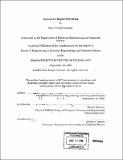| dc.contributor.advisor | Harold Abelson. | en_US |
| dc.contributor.author | Leonard, Sean Joseph | en_US |
| dc.contributor.other | Massachusetts Institute of Technology. Dept. of Electrical Engineering and Computer Science. | en_US |
| dc.date.accessioned | 2007-03-12T17:54:04Z | |
| dc.date.available | 2007-03-12T17:54:04Z | |
| dc.date.copyright | 2005 | en_US |
| dc.date.issued | 2005 | en_US |
| dc.identifier.uri | http://hdl.handle.net/1721.1/36791 | |
| dc.description | Thesis (M. Eng.)--Massachusetts Institute of Technology, Dept. of Electrical Engineering and Computer Science, 2005. | en_US |
| dc.description | Includes bibliographical references (leaves 70-72). | en_US |
| dc.description.abstract | A system for rapid subtitling of audiovisual sequences was developed, and evaluated. This new system resulted in average time-savings of 50% over the previous work in the field. To subtitle a 27-minute English lecture, users saved 2.2 hours, spending an average of 1.9 hours timing the monologue. Subtitling a 20-minute Japanese animation resulted in similar savings. While subtitling is widely practiced, traditional speech boundary detection algorithms have proven insufficient for adoption when subtitling audiovisual sequences. Human-edited timing of subtitles is a dull and laborious exercise, yet with some human-guidance, basic systems may accurately align transcripts and translations in the presence of divergent speakers, multiple languages, and background noise. Since no known, fully-automatic recognition systems operate with sufficient accuracy for production-grade subtitle times, during playback the system disclosed treats user-supplied times as a priori data and adjusts those times using extracted features from concurrent data streams. In the application's oracle subsystem, packaged algorithms called oracles preprocess, filter, and present media data, using that data to adjust user-supplied times. | en_US |
| dc.description.abstract | (cont.) The on-the-fly timing subsystem gathers user-supplied times and coordinates the oracles' adjustment of the data. The application was developed with attention to user interface design and data format support, and was sent to users for structured feedback. From these data, system performance is discussed in terms of subtitle time accuracy, time spent by users, and avoidance of common pitfalls in subtitle generation. | en_US |
| dc.description.statementofresponsibility | by Sean Joseph Leonard. | en_US |
| dc.format.extent | 109 leaves | en_US |
| dc.language.iso | eng | en_US |
| dc.publisher | Massachusetts Institute of Technology | en_US |
| dc.rights | M.I.T. theses are protected by copyright. They may be viewed from this source for any purpose, but reproduction or distribution in any format is prohibited without written permission. See provided URL for inquiries about permission. | en_US |
| dc.rights.uri | http://dspace.mit.edu/handle/1721.1/7582 | |
| dc.subject | Electrical Engineering and Computer Science. | en_US |
| dc.title | System for rapid subtitling | en_US |
| dc.type | Thesis | en_US |
| dc.description.degree | M.Eng. | en_US |
| dc.contributor.department | Massachusetts Institute of Technology. Department of Electrical Engineering and Computer Science | |
| dc.identifier.oclc | 79625196 | en_US |
